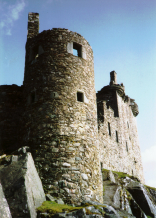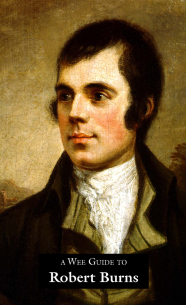Robert Burns 1759-84: His Father’s Son
My father was a farmer upon the Carrick border, O;
And carefully he bred me in decency and order, O;
He bade me act a manly part, though I had ne’er a farthing, O;
For without an honest manly heart, no man was worth regarding, O.
The spelling of the family name had been Burnes or Burness, and they came from the north of Scotland, from Kincardineshire, where the poet’s grandfather and namesake, Robert Burnes, had been a gardener at Inverugie Castle. They rented land directly from the Earl Marischal, and were thus comfortable farming people, with status in their local community.
The story runs that the family were sympathetic to the Jacobite cause enshrined in Bonnie Prince Charlie and the uprising of 1745. Given their Highland roots this would not be surprising, and Robert Burns himself had in adult life a romantic attachment to the Stewart cause.
Whatever their true sympathies, the Burnes family suffered economically as a direct consequence of the uprising and the punitive measures taken against the Highlands by the London government. William Burnes, the elder Robert’s son, had been born in 1721, the youngest of three sons. In 1748 the family went their separate ways in order, simply, to survive – one son to Montrose, one to Ayrshire, and William to Edinburgh, where he found work as a landscape gardener.
William’s description of the pain he felt at parting from his brothers, each facing an unknown future, made a great impression on his sons. His second son Gilbert later wrote: ‘I have often heard my father describe the anguish of mind he felt when he parted with his elder brother Robert on the top of a hill ... each going off his several way in search of new adventures, and scarcely knowing whither he went.’
For two years William worked in the capital – for some time in that part where a loch had been drained and known as The Meadows. But in 1750 he moved west, to Ayrshire, with ambitions to restore his family’s fortunes as tenant farmers. For a while, he was gardener to Alexander Fairlie, an Ayrshire laird. This was no unimportant post, for the gardens of a great house not only testified to a man’s position by their beauty and the modernity of their landscaping – gardening being the ‘new’ art form of the eighteenth century – but in practical terms put fruit and vegetables on a man’s table to feed his family and his guests.
But William Burnes moved on – he acquired seven and a half acres at Alloway and set up as a nurseryman himself, although as this alone was insufficient to support a family, he also worked as head gardener at Doonside, a private estate. On 15 December 1757 William married Agnes Brown, a farmer’s daughter from Kirkoswald whom he may have met at Maybole Fair in 1756. Agnes had pale red hair and a temper to match, though a cheerful disposition, and was a capable farm-bred woman: the eldest of six and motherless from the age of ten, she had looked after her younger siblings when their mother died.
To house his wife and family, William built a house on that seven and a half acres with his own hands. This was a traditional but-and-ben, the ‘auld cley biggin’ Burns described, a simple dwelling with a clay floor and a peat-burning fire. Box-beds might have a concealing curtain, but life in such cottages was a public affair. Children slept with their parents, though the boys might sleep with the animals in the byre. There might be one chair for the patriarch of the family, one cooking pot and a lamp above the fire. In the long winter evenings, a lull in song or conversation would be punctuated by the snufflings and shufflings of the animals behind the dividing wall.
The first child of William and Agnes was born on 25 January 1759 and named Robert for his grandfather. When Robert was a few days old, a violent storm blew up and the gable end of the cottage collapsed. Mother and baby took shelter with a neighbour until the damage was repaired.
Six more children were to follow over the years: Gilbert – to whom Robert was very close in affection as well as age – Agnes, Annabella, William, John and the last, Isabella, in 1771. Describing that clay but-and-ben, John Murdoch, tutor to the elder boys, wrote: ‘In this cottage ... I really believe there dwelt a larger portion of content than in any Palace in Europe. [Burns’ poem] ‘The Cotter’s Saturday Night’ will give some idea of the temper and manners that prevailed there.’
The cottage was soon overflowing with children, and in 1765 William Burnes took a 12-year lease on a farm at Mount Oliphant, two miles from Alloway. Burnes was required to make a huge capital investment to stock the farm – a sum over twice the annual rental. Both at Mount Oliphant and later at Lochlie – the farm in Tarbolton parish to which he moved in 1777 – William’s story, and that of his family, has the same tragic theme: back-breaking and relentless physical toil, the gradual erosion of whatever meagre savings or capital might have been saved, debts and disappointments mounting with each poor harvest, each harsh winter, every unrewarding spring.
In his poems and songs, Robert Burns reveals an acute understanding of the farmer’s life with its utter dependence on the soil, the seasons and the beasts. He did not learn this sympathy, but saw it lived, in his father, his brothers and himself.
Agnes churned the butter, made the cheese and minded the children with a fierce and loving eye. She also, not incidentally, possessed an ear for music and a fine singing voice – two attributes her eldest son always found irresistible in a woman.
William Burnes was a Calvinist and a stern, uncompromising upholder of that dry morality against which Robert would later rail. The only letter in existence from Robert to his father begins ‘Honoured Sir’ which may speak more of respect than love. William found much to exasperate and appal him in a son who so relished such pastimes as dancing and music, yet clearly the bond between the two was close. Robert described his father as ‘the best of friends and the ablest of instructors’, and William is the inspiration for the douce guidman or gentle patriarch of ‘The Cotter’s Saturday Night’. At the Burns Birthplace Museum a printed copy of William’s Manual of Religious Belief may be seen, a book he wrote in longhand for the moral instruction of his children.
The greatest gift William gave his sons was their education. Life at Mount Oliphant was hard and the family might not see meat on the table from one year to the next, but William placed a value on education that was worth every sacrifice.
When Robert was six, William engaged one John Murdoch to teach his own sons and those of certain neighbours. Murdoch was 18 at the time, and described William Burnes as ‘by far the best of the human race that he ever knew’. Murdoch liked the Burnes boys, though it was the cheerful and good-natured Gilbert that was his favourite, and he enjoyed his visits to the cottage he called the ‘mud edifice’. The teaching took place in Alloway – a walk of two miles each way, one uphill, one down.
The boys learned to read, to write a little, and mastered the rudiments of grammar. Robert, not surprisingly, became an enthusiastic reader – The Life of Hannibal was an early and treasured favourite. Long passages from the Bible and Shakespeare were learnt by heart. This, however, was Murdoch’s verdict on the boy whose adult life was passed in the creation and embellishment of Scottish songs: ‘[His] ear was remarkably dull, and his voice untunable’.
It is worth noting Burns’ fluency from boyhood in both his native Scots and in the version of English spoken in Edinburgh drawing-rooms, as well as south of the Border. He was easy with both, as his vast output of letters in either tongue shows – over 700 exist today – and never devalued Scots as being in any way inferior, even when his Edinburgh patron Henry Mackenzie suggested that his poems might have wider appeal if they were written in English.
The three years of formal education in Mr Murdoch’s schoolroom ended when Robert was nine, and were the longest sustained period of education in his life. The money could scarce be found and besides, the boy was big enough to take on a job of work on the farm: threshing the grain, and weeding. Later he would walk behind the plough.
His education thereafter was erratic, a matter of weeks here and there spared from farm work. Whenever books or visitors from beyond the confines of the farm came his way, Robert clung to them hungrily. One glorious summer he was sent to Ayr for two weeks, to some relations of his mother’s, where he was allowed to use the library and saw, for the first time, rows upon rows of books, all waiting to be read. John Murdoch was by this time a Master at Ayr Academy, and Robert studied again with him. He did in fact learn a little Latin, though in later life he declared that the only Latin of which he had need was omnia vincit amor – love conquers all.
In 1772 William Burnes sent Robert and Gilbert to a school in Dalrymple for a few weeks – in a building now the White Horse Hotel – in order that their handwriting might be improved. While here, Robert read a book about William Wallace, the thirteenth-century Scot who became a particular hero to the boy.
As he grew into a young man, the sense of frustration within Robert became more apparent. He is described in these years as touchy, proud and sure of himself. A boy doing a man’s work, he must have yearned for the world of books, of conversation, of education, that was so tantalisingly beyond his reach. He knew himself to be intelligent and able – but the circumstances of his life required him to weed the furrows before the plough, and tend to animals when he would so much rather tend to the world of imagination and ideas instead. His brother Gilbert noted in him a tendency to envy others: ‘Robert cherished a particular jealousy of people who were richer or of more consequence than himself.’ The lines he wrote in ‘Man was Made to Mourn’ have a particular ‘eloquence’:
If I’m designed yon lordling’s slave,
By Nature’s law designed,
Why was an independent wish
E’er planted in my mind?
In 1777, when Robert was 18, his father freed himself from the exhausting burden of Mount Oliphant and the family moved to Lochlie, which lies between Tarbolton and Mauchline. William now paid his two sons a man’s wage as ploughmen: £7 a year.
The nearby town of Tarbolton provided Robert with new excitements. He was still reading books whenever he could find them, and at Tarbolton first read a novel, popular at the time, which became his lodestar: The Man of Feeling. It was ‘a book I prize next to the Bible’, Burns told Mackenzie later, when the two men became friends in Edinburgh. The book is now unreadable, but it was big on ‘sensibility’ – that vague quality of emotional delicacy which a young poet would find inspiring.
In Tarbolton, in 1780, Robert and Gilbert founded a debating society which they called the Bachelors’ Club. Apart from the obvious qualification, candidates for membership were required to have ‘a frank, honest, open heart; above anything dirty or mean; and must be a professed lover of one or more of the female sex’. This last was probably more wishful thinking on Robert’s part than anything else: his thoughts were increasingly occupied with the delights of courtship and the confusions of lust, even though his efforts in that direction had as yet been unlucky.
His courtship of one Alison Begbie – ‘a belle-fille whom I adored’ – was conducted by letter and he seems to have wanted to marry her. The facts of this ponderous courtship have been debated by Burns scholars, but the letter proposing marriage is hardly prose to melt the heart:
‘If you will be so good and so generous as to admit me for your partner ... there is nothing on this side of eternity shall give me greater transport.’
Whatever the truth, Alison rejected him, chose another, and Burns claimed to have been mortified by the experience. Some even believe this early failure to marry a local lass of good standing and thus replicate his parents’ marriage is a key to his later development.
Tarbolton was also the place where Robert attended a dancing class ‘to give my manners a brush’. His father was utterly opposed to his attendance, but Robert went anyway.
A lifelong friend, Davie Sillar, describes Burns as already appearing very different from other people: ‘His social disposition easily procured him acquaintance; but a certain satirical seasoning ... while it set the rustic circle in a roar, was not unaccompanied by its kindred attendant – suspicious fear ... He wore the only tied hair in the parish...and in the church, his plaid, which was of a particular colour [black and white] ... he wrapped in a particular manner round his shoulders.’
His appetite for life beyond the farm was confirmed by an important event in his life: in 1781 Robert became a Freemason, initiated on 4 July in Lodge No. 174, St David’s. Freemasonry was then at the height of its popularity and was a sure route to social acceptability. The author of Burns’ favourite book, Henry Mackenzie, was also a mason and one of a distinguished and influential group of masons who welcomed Burns to Edinburgh in 1786 and guaranteed the young poet an entree into all the best circles of society. It was through masonic contacts, as much as his poetry, that Burns was able to mix freely with the rich and the titled.
The romantic ritual of Freemasonry, with its roots in myth and antiquity, satisfied Burns’ need for colour and magic in life. More than this, however, eighteenth-century Freemasonry applied the principles of international brotherhood, of fraternal loyalties which transcended class and creed. This ‘brotherhood of man’ was a concept which grew in importance and value in Burns’ life and found ultimate expression in his passionate support for the egalitarian philosophies behind the American and the French Revolutions.
Leisure to indulge in revolutionary fervour was limited, however, by the continuing struggle to make ends meet. As a later poet noted, a different address may only land you in a different kind of mess, and this was certainly true of the move to Lochlie.
The previous chapter described the eighteenth-century revolution in agriculture: this wrench from old to new was achieved by men like William and Robert. The containment of open heathland involves the building of walls, of drains, of ditches – when the old gives way to the new there is immense work to be done in installing the new, but the daily work must go on nevertheless.
In Robert’s case, building a wall or draining a field still meant the animals had to be fed and the fields ploughed. He wrote tellingly to a cousin: ‘Our landholders, full of ideas of farming gathered from the English and the Lothian and other soil in Scotland, make no allowance for the odds of the quality of the land, and consequently stretch us much beyond in the event, we will be found able to pay.’
What might have worked on fertile, robust soil, withered and died in the sour, stony earth of Lochlie. What is remarkable, though, is that what was flourishing in these years of hardship was the spirit of poetry within Robert Burns. Grabbing at passing morsels of education where they could be found, spending long hours on the land in the hardest of physical work, his eye and his heart remained alive to beauty and to music, finding them equally in pretty girls, in the natural world around him, and in the companionship of friends. No one can be certain exactly when he began to write verse, but one can be certain that the spirit of poetry was thriving as surely as the crops were withering at Lochlie.
In 1781 the 22-year-old Robert went to Irvine, an Ayrshire town made a royal burgh by Robert the Bruce, to learn the trade of flax-combing. At Lochlie, the Burnses had been growing flax as an additional crop, and it was in the interests of expanding the family business that Robert apprenticed himself to one Mr Peacock, flax-dresser or ‘heckler’. Rob stayed for six miserable months, during the course of which he was very ill with pleurisy.
But in Irvine there was a bookshop – Templeton’s – and Robert spent a great deal of time there, impressed to learn that a poet called Robert Fergusson had earned as much as £50 from publishing a book called Scots Poems. The fate of that young and tragic poet moved Burns – Fergusson had died mad and penniless in 1774. Robert Burns freely acknowledged the influence of Fergusson on his own work and in 1787 paid for the erection of a tombstone over his unmarked grave in Edinburgh’s Canongate churchyard.
At Irvine Rob made a friend, Richard Brown, a seaman. Burns wrote: ‘His knowledge of the world was vastly superior to mine, and I was all attention to learn. He added: He was the only man I ever saw who was a greater fool than myself when woman was the presiding star...’
It was to Brown, one Sunday in Eglinton woods, that Burns repeated some of his verses. Brown was impressed, and suggested that Burns send some of his poems to a magazine: ‘and that,’ wrote Burns, ‘encouraged me to endeavour at the character of a Poet.’
In Irvine, Burns tasted the ‘new drink’ lately come from the Highlands – whisky. He lost all his possessions in a fire and he lost his virginity too – presumably in a fire of another kind. But the flax-dressing venture failed, and he was needed at home where William Burnes was facing legal action for arrears of rent.
In January 1784 Burns was 25 years old: he had 12 years of life left to him, and the long years of farm work had almost certainly weakened his health in a way that would kill him. Apart from the six months at Irvine, he had lived his life under his father’s roof, abiding by his father’s principles, under the shadow of his father’s misfortune.
Then everything changed. Broken by anxiety and ill luck, William Burnes had been ailing for months. Appealing against the sequestration of Lochlie for arrears of rent had cost him literally the last he had.
On the morning of the 13 February, Robert and his sister Isabella were distressed to find the poisoned body of Rob’s dog Luath outside their door – the act of a vengeful neighbour. It must have seemed a sombre omen. With his children gathered round his bed, William said: ‘There is only one of you I am afraid for’. His eyes were on Robert. By evening, the father was dead.
Robert was now head of the family, and his own life could begin.
© Martin Coventry & Dilys Jones 2017









